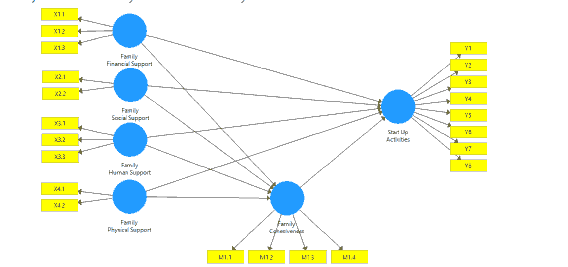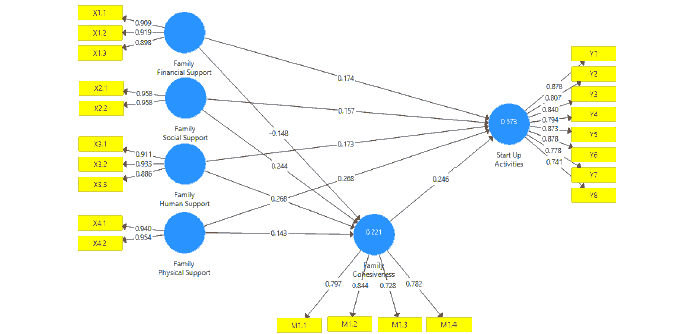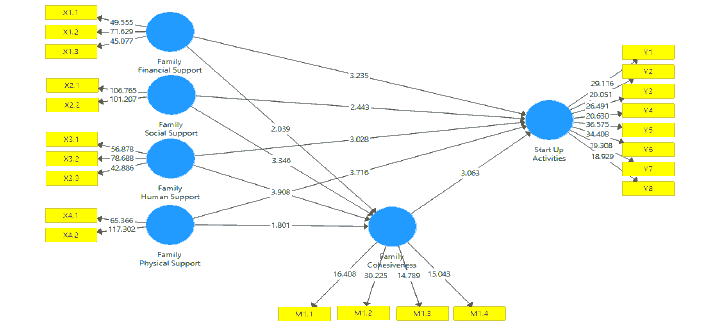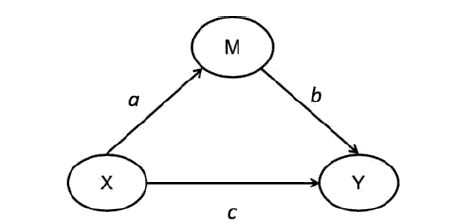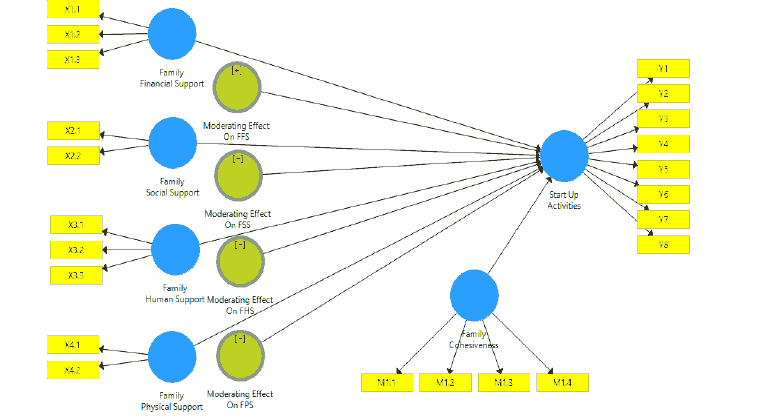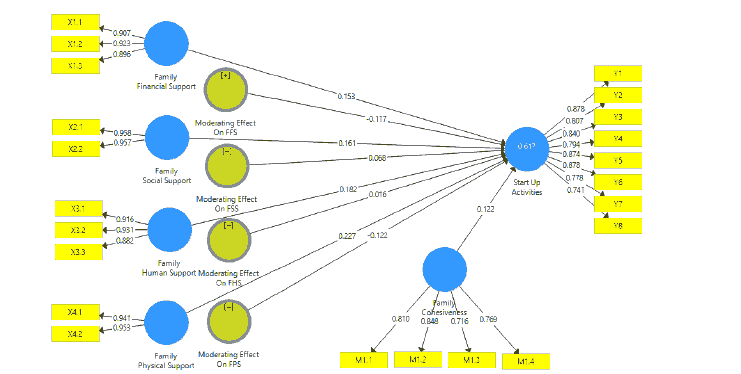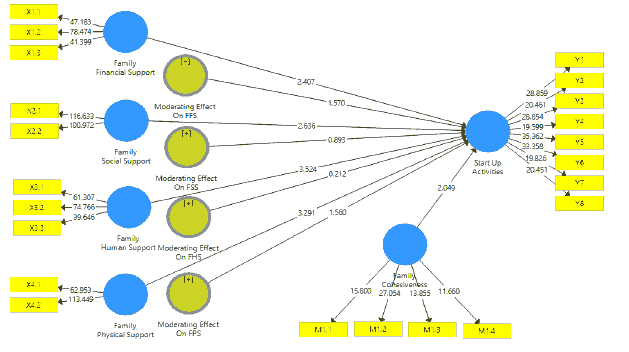Research Article: 2021 Vol: 24 Issue: 1S
The Effect of Types of Family Support on Startup Activities in Indonesia with Family Cohesiveness as Moderation
Nabilah Aliyyah, Universitas Gadjah Mada and Universitas Wijaya Putra
Sari Winahjoe Siswomihardjo, Universitas Gadjah Mada
Indra Prasetyo, Universitas Wijaya Putra
Rusdiyanto, Universitas Airlangga and Universitas Gresik
Arif Syafi'ur Rochman, Universitas Gresik
Nawang Kalbuana, Politeknik Penerbangan Indonesia Curug
Abstract
The purpose of this study is to analyze the relationship of types of family support on start-up activities in Indonesia through family cohesiveness as mediation and moderation; this study used respondents as many as 198 students from Yogyakarta, Indonesia. This study provides analytical information using path analysis with SEM-PLS applications. The results of this study explain that family cohesiveness as a mediation and moderation variable has astounding comparative results; in the effect mediation, if Family Cohesiveness as a mediation variable, it can make the direct relationship of FPS to SUA initially significant even if Family Cohesiveness as a moderation variable direct relationship FPS to SUA has a weak strengthening effect as evidenced by the value of F Square only 0.017 below 0, 02.
Keywords:
Family Cohesiveness, SEM-PLS Applications, Relationship
Citation Information:
Aliyyah, N., Siswomihardjo, S.W., Prasetyo, I., Rusdiyanto, Rochman, A.S., & Kalbuana, N. (2021). The effect of types of family support on startup activities in indonesia with family cohesiveness as moderation. Journal of Management Information and Decision Sciences, 24(S1), 1-15.
Introduction
Youth unemployment in Indonesia is the highest among other age groups, approximately 16.73 percent (Global Economy, 2019). Youth unemployment refers to young people in the age of 15-24 years old without work, but are currently seeking or available for employment. In general, unemployment is a serious issue faced by both developed and developing nations because this issue leads to economic and social matters (Akutson, Messiah & Dalhatu, 2018) ¬. This suggest that youth unemployment problems cannot be separated from larger issues and questions among the discussion of economic growth.
We can all agree that getting a college degree does not guarantee employment for fresh graduates. Therefore, entrepreneurship courses are now being offered in most of colleges and universities (Katz, 2015). Another way to make a living other than getting employed is by self-employment and new venture development, these activities can begin to help tackling the youth unemployment problems. Individual self-empowerment can be fostered by entrepreneurship activities, which also can serve as a tool to create jobs, economic growth, innovation, and reinvigoration of economic life (Kelly et al., 2011; Audretsch, 2007).
One of the most important goals of a nation is to keep reducing the unemployment rate. Focusing on youth unemployment, providing entrepreneurial knowledge for students in schools and universities will increase awareness towards entrepreneurship as we know students are entering the working age. When developing new ventures is one of the main weapons in combating youth unemployment, understanding of factors which could possibly influence young people in starting up new business is extremely important. When looking at the index of easiness of doing business, Indonesia is ranked as 73th among the total of 190 economies that make business easier (World Bank, 2018). This rank stayed unchanged at 73 two years in a row, in 2019 and 2018. The Facilitative Business Index in Indonesia was 106.42 on the average from 2008 to 2019, at 129 in 2008, and at a record low of 72 in 20178. (Trading Economics, 2019). According to Lestari (2019), factors that influence the success of entrepreneurship are; interest and talents, motivation, and knowledge. Motivation was defined as three types; internal motivation, external motivation, and urgent motivation. One of the external motivations is the family support. For young people, family is one of the most important sources of early stage and seed funding (Bygrave, Hay, Ng & Reynolds, 2003), & mentoring (Sullivan, 2000). Some authors suggest that emotional support from family is what encourage young people to start their entrepreneurship activities, while others suggest that the instrumental or tangible support is what really encourage them (Sorensen, 2007).
Literature Review
Family Support
Families play an important role in the company process in terms of the strong links between family integration and entrepreneurial outcomes or actions (Aldrich & Cliff, 2003). Especially for young nascent entrepreneurs, family plays an important role in majority of young entrepreneurs’ activities especially when they do not have their own capital to support the business. According to Hatak & Zhou (2019), family or capital support strengthens a contractor's welfare and business performance. On one hand, family support affects entrepreneurs’ willingness to work hard, hence increase business performance. On the other hand, Sieger & Minola (2017) argues that support from family members reduces entrepreneurs' likelihood of establishing enterprises. The positive and negative perception of family support is a cause for debate. In this research, the discussion is focusing on four types of family support, financial, social, human, and physical support.
Family Financial Support
The definition of family capital means financial resources, social, and human made available to individuals or groups through family affiliation. (Nahapiet & Ghoshal, 1998; Danes, 2009). It is undoubtedly true that every new venture and every business need financial capital to operate and therefore getting the return they deserve. According to Pena (2002), financial capital provides flexibility for entrepreneurs to handle a broader range of startup activities. Financial capital is very critical in every business’ sustainability. Especially for new venture, entrepreneurs’ first challenge is to get the financial capital from. In accidental external shocks, financial capital can protect businessmen from imitations by enabling them to implement more capital-intensive strategies (Cooper, Gimeno-Gascon & Woo, 1994). Chua, et al., (2011) found that the relation between family involvement and debt finance in new enterprises has a positive influence. When young student entrepreneurs, without previous experience of working, looking for early-stage funding, they are able to benefit from family financing or family connections.
Family Social Support
Social capital is the second type of capital that parents or families can provide. Business capital is defined as the network of relationships which are closely connected with personal and organizational contacts according to Bastie, et al., (2013). For human-to-human activities that operate in a company, social capital is needed. Social players can use these relationships to access resources, information and social approvals (Stuart & Sorenson, 2007; Hoang & Antoncic, 2003; Newbert, Tornikosli & Quigley, 2013). Although a family does not participate directly in business processes and initiatives, the social capital of the family can still influence risk creation (Aldrich & Cliff, 2003). Beside the direct impact of families on existing social networks in their families, family social capital enables additional resources to be mobilized to be successful in start-ups.
Family Human Support
The human capital concept is embedded inside the idea that people own skills, knowledge, and experience with economic value for themselves and also their firms (Centidamar et al, 2012). Family human capital is the knowledge, abilities, and skills possessed by individuals in the family members (Coleman, 1988). Human capital is mostly contemplated to be the most important resource in any business. In the entrepreneurship literature, nascent entrepreneur who has entrepreneurial knowledge and experience background most likely are already exposed to the kinds of activities needed in order to start a business. One of many forms of family human capital is mentoring. Chlosta, et al., (2014) suggests that the decision to start a business has a positive correlation with having family members or parents who are or were entrepreneurs, related to the mentoring facility for the children from entrepreneur parents.
Family Physical Support
When seeing family capital from a bigger point of view, it includes the other types of capital namely social, financial, and also human capital, alongside other tangible assets also known as physical capital (Danes et al., 2009). Physical capital is considered as other tangible assets, family physical capital is tangible assets provided by the family such as house, family vehicle, computers, that are used for business purposes (Dyer et al., 2014).
Family Cohesiveness
Family cohesiveness is defined as the calculation of connectivity and emotional attachments inside a family (Lansberg & Astrachan, 1994). As young nascent entrepreneurs, family can be said to be one of the most used sources of capital. Family cohesiveness is crucial as young entrepreneurs are lacking of experience and also relationships with business people, therefore family connections are needed. Edelman, et al., (2014) argued that family cohesiveness magnified the effect generated by family social capital on students’ startup activities. Therefore, the writer finds it interesting to see how family cohesiveness influence startup activities of young student entrepreneurs in Yogyakarta. Pearson, et al., (2008) found that family “Time and stability all strengthen family capital, interdependency, interaction and closure. Supporting that finding, Edelman, et al., (2014), argues that family cohesiveness had a positive moderating effect on three aspects of family support, namely social, human, and also physical capital support.
Although there are positive moderating effects on three different types of capitals, the family financial capital was not significantly affected by family cohesiveness. Furthermore, Edelman, et al., (2014) also found that family cohesiveness negatively influencing startup activities of young nascent entrepreneurs.
The Relationship between Financial Support from Family and Startup Activities
Due to its relatively younger age and lack of collateral or credit history, the majority of common means of early stage financial support for a company, such as cards or loans from banks, are less likely to be available for university students (Ozgen & Minsky, 2013). In terms of looking for financial capital, young, student entrepreneurs have the ability to utilize their relationship with their families. A recent study by Chua, Chrisman, Kellermanns, Wu (2011) shows that family involvement positively influences new venture debt financing. Therefore, it is concluded that family-provided finance could be one of the most substantial sources of financial support for young entrepreneurs, especially students.
The Relationship between Social Support from Family and Startup Activities
Families have a duty to assume responsibility for the actions of their members, which allow families to "borrow" the social capital of their families. Chua, et al., (2011), for example, documented that family involvement has influenced debt financing by exploiting the relations between family members and resource owners. Children have the privilege of having access to parent-contractor social capital, including connections with business partners, vendors and potential customers and can benefit from their parent networks in order to start a new business (Laspita et al., 2012). Empirical evidence from the literatures about student entrepreneurship shows that students who had family business backgrounds derived from a specific familial context that has the possibility to influence their future career intentions (Laspita et al., 2012).
The Relationship between Family Human Support and Startup Activities
Family human capital is the skills, knowledge, and abilities of individuals in the family members (Coleman, 1988). Young nascent entrepreneurs are typically lacking both entrepreneurial experience and managerial experience, therefore they turn to the family as a strategy to control their human capital needs (Hoang & Antoncic, 2003). Children’s future professional orientation is also influenced by their previous social education from parents as role models (Carr & Sequeira, 2007).
One form of family human capital is mentoring. Research suggests that choice to start a new venture has a positive correlation with having entrepreneur parents (Chlosta, Patzelt, Klein, Dormann, 2010). Thus, young entrepreneurs are who are facilitated with knowledge from the family in terms of entrepreneurship based on experience.
The Relationship between Family Physical Support and Startup Activities
Family physical capital includes assets owned by family, such as use of the family house as operational office for business, family-owned vehicles, gadgets, and other tangible needs to begin a new business (Dyer et al., 2014). According to Sirmon & Hitt, (2003), family’s existing capital is able to help support businesses during the period of lower economic times or after a failed business extension and/or new market venture. Without such family support, student nascent entrepreneur has to find the other source of these tangible resources.
Goals & Abilities, Role Models, Remuneration, Justice
As shows in Figure 1.
Research Hypothesis
Following these definitions, a hypothesis has been created based on these data that matches these research objectives and the overall conceptual framework:
1. H1: Family financial support affects start-up activities positively
2. H2: Family social support affects start-up activities positively
3. H3: Family human support affects start-up activities positively
4. H4: Family physical support affects start-up activities positively
5. H5: Family cohesiveness affects start-up activities positively
6. H6: Family financial support has a positive effect on Family cohesiveness
7. H7: Family social support has a positive effect on Family cohesiveness
8. H8: Family human support has a positive effect on Family cohesiveness
9. H9: Family physical support has a positive effect on Family cohesiveness
Research Method
Type of Research, Sample and Population, Sampling Technique
This research use causal research, a quantitative research that uses statistics to address specific problems or research hypotheses for predicting whether a certain variable affects the rest of the variables ( Prasetyo, Aliyyah, Rusdiyanto & Nartasari, et al., 2021; Prabowo, 2020; Juanamasta, 2019; Luwihono, 2021; Kalbuana, 2021; Aliyyah & Rusdiyanto, et al., 2021; Prasetyo, Aliyyah, Rusdiyanto & Suprapti, et al., 2021; Prasetyo, Aliyyah, Rusdiyanto & Tjaraka, et al., 2021; Shabbir, 2021; Rusdiyanto & Agustia, 2020; Hidayat, 2020; Rusdiyanto & Karman, 2020; Susanto, 2021; Abadi et al., 2021; Aliyyah et al., 2021; Hastomo, Karno, Kalbuana, Meiriki & Sutarno, 2021; Kalbuana, Suryati, et al., 2021; Kustiningsih et al., 2020; Prasetyo, Aliyyah, Rusdiyanto, Kalbuana & Rochman, 2021; Prasetyo, et al., 2021; Prasetyo, Aliyyah, Rusdiyanto & Nartasari, et al., 2021a; Prasetyo, Aliyyah, Rusdiyanto, Utari, et al., 2021). University students in Yogyakarta, Indonesia, who had experience or currently experiencing entreneurship activities, because the target population will be able to provide desired information regarding family support on their experience in entrepreneurship. This research used non-probability sampling. The method of sampling employed was intended to perform a sample based on sample criteria described by sample investigator.
Operational Variables Definition
The operational variables definition in this study consist of:
Family Financial Support (X1) Edelman et al (2014)
x1.1: My family gives me the capital of debt
x1.2: My family gives me equity capital
x1.3: My family provides capital that has flexible and favorable conditions
Family Social Support (X2) Edelman et al (2014)
x2.1: My family gives me contacts to persons who could help me in a entrepreneurial career
x2.2: My family introduces me to corporate networks and contacts with potential customers
Family Human Support (X3) Edelman et al (2014)
x3.1: My family gives me general understanding of how to run a company
x3.2: My family offers knowledge on how to produce a service/product
x3.3: In my entrepreneurial activity, my family is a coach or mentor
Family Physical Support (X4) Edelman et al (2014)
x4.1: My family provide me with locations or facilities for my entrepreneurial activities
x4.2: My family provide me access to a distribution network for my company
Family Cohesiveness (M) Edelman et al (2014)
m1.1: Togetherness with family is important
m1.2: Family member feels very close
m1.3: When the family gathered, everyone was present
m1.4: Family members ask for help from each other
Start up activities (X4) Edelman et al (2014)
y1.1: The idea of the first business
y1.2: Development of a business plan
y1.3: Identified market opportunities
y1.4: Finding potential partners
y1.5: Purchased equipment
y1.6: Working on product development
y1.7: Discussing with potential customers
y1.8: Asked formal/nonformal parties for funding
Technical Data Analysis
The research has used the following phases of PLS-SEM analysis: 1. A reliability evaluation was conducted in two sessions, i.e. the evaluation of reliability markers and the assessment of internal consistency. 2). Conduct an assessment using convergent and discriminant validity of the information. 3) Perform the bootstrapping test in order to obtain P value and a statistical value. Testing of the mediation of indirect influences. as shows in Figure 2 and Table 1.
| Table 1 Convergent Test |
|||||
|---|---|---|---|---|---|
| Variable | Cronbach's Alpha | rho_A | Composite Reliability | Average Variance Extracted (AVE) | Information |
| Family_Cohesiveness | 0.799 | 0.812 | 0.868 | 0.622 | Valid |
| Family_Financial Support | 0.895 | 0.895 | 0.934 | 0.826 | Valid |
| Family_Social Support | 0.910 | 0.910 | 0.957 | 0.917 | Valid |
| Family_Human Support | 0.897 | 0.912 | 0.935 | 0.829 | Valid |
| Family_Physical Support | 0.885 | 0.895 | 0.946 | 0.897 | Valid |
| Start Up_Activities | 0.932 | 0.938 | 0.944 | 0.681 | Valid |
On the basis of the Convergent Test table, the value for fitness tests must be below the standard above 0,5 and in the first stage because the six CA variable values are above 0,7; CR above 0.7 and AVE above 0.5 then the model is automatically fit, and no indicators are eliminated so that it can continue testing hypotheses through the inner model test with bootstrapping features as follows: as shows in Figure 3.
The T-statistical value and the hypothesis test are for drawing conclusions from the above bootstrapping model. The 5% Table value for the 198 respondents describes that if the T statistical value is higher than the T table of 1,96 the internal model is significant. as shows in Table 2.
| Table 2 Path Coefficient t-Statistics |
||||||
|---|---|---|---|---|---|---|
| Hypothesis | Original Sample (O) | Sample Mean (M) | Standard Deviation (STDEV) | T Statistics (|O/STDEV|) | P Values | Information |
| Family_Financial Support -> Start Up_Activities | 0.174 | 0.175 | 0.054 | 3.235 | 0.001 | Significant |
| Family_Social Support -> Start Up_Activities | 0.157 | 0.156 | 0.064 | 2.443 | 0.015 | Significant |
| Family_Human Support -> Start Up_Activities | 0.173 | 0.174 | 0.057 | 3.028 | 0.003 | Significant |
| Family_Physical Support -> Start Up_Activities | 0.268 | 0.260 | 0.072 | 3.716 | 0.000 | Significant |
| Family_Cohesiveness -> Start Up_Activities | 0.246 | 0.252 | 0.080 | 3.063 | 0.002 | Significant |
| Family_Financial Support -> Family_Cohesiveness | -0.148 | -0.147 | 0.073 | 2.039 | 0.042 | Significant |
| Family_Social Support -> Family_Cohesiveness | 0.244 | 0.240 | 0.073 | 3.346 | 0.001 | Significant |
| Family_Human Support -> Family_Cohesiveness | 0.268 | 0.269 | 0.069 | 3.908 | 0.000 | Significant |
| Family_Physical Support -> Family_Cohesiveness | 0.143 | 0.146 | 0.079 | 1.801 | 0.072 | No Significant |
In the above table it can be said that the original sample value is a coefficient value, which is shown in the latent variable's strength, whilst the medium value of the path coefficient is shown in the column mean (m), otherwise the std. dev and std.error show the value of deviation and errors in this sample.
T- statistics on the impact on start-up activity of family financial help shows that 3,235 is higher than T-table 1,96 with a probability of 0,001 which is less than five percent. T- The statistics on the impact of family social support on start-up activities show that the numbers of T- table 1,96 are 2,443 higher and have a probability value of 0,015 which is smaller than 5 percent. T- Statistics on the effects of family personal support for start-up activity show that the number is 3,028, which is greater than T- Table 1,96 and that its probability of 0,03, which is less than 5 percent. T- The statistics on the effect of physical support for start up activities show a number of 3,716 higher than T- table 1,96 with the likelihood that the value of a probability of 0,000 is less than 5 percent. T- Statistics in the effect of family cohesion on start-up activities show that a 3,063th annual number is higher than the one T- Table 1.96, with an oversight value of 0.002, lower than 5 percent.
T - Statistical data on the impact of family financial assistance on family cohesiveness show that the number of family financial support measures is 2,039 higher than Table 1,96, with a likelihood of 0, 042 less than 5%. The statistical data on the effect of social support for families show that family cohesion has a number of 3,346 higher than Table 1.96, with probability value below 0.001 that is below 5 per cent. · Statistics on family support's influence over family cohesion show that Table 1 96 shows a number of three hundred and ten hundred and ten eight hundred and six eight eight eight with a probability value of 0.000 lower than five percent. T- Family support statistics show that 1.801 are lower than T-table 1.96 with probability of 0.072 that is higher than 5 percent. This means that physical support for the family does not have a major impact on family cohesion.
Evaluation of Indirect Effects
Using the measuring indirect effect, Smart PLS includes the findings from the measurements of the variable mediator. Mediation occurs if a variable is directly linked to the dependent. This shows that variables dependent on the basic variables changed as a result of changing the basic variables. The author uses a simple mediation model in this article because a mediator variable is available. The author takes the flow provided by In order to investigate this simple mediation model (Zhao, Lynch Jr, & Chen, 2010; Curll & Brown, 2020; Erebak & Turgut, 2020; Kelcey, Bai, & Xie, 2020; Ramoz et al., 2020; Toka, Recse, Cserep, & Szabo, 2020) This mediator's model is simple. Direct impact: c Direct impact: c Multiplication of axb: axb Multiplication of axb: axb Total effect: c + (axb). as shows in Figure 4.
Zhao, Lynch Jr, & Chen, (2010; Kang, Shin & Lee, 2020; McCallaghan, Jackson & Heyns, 2020; Mühlhauser, Vogt & Niederer, 2020; Spagnoli et al., 2020; Wu, Huang, Hsu & Hong, 2020; Yuan, Fu, Han, Chen & Fang, 2020) Extended that the mediation impact is divided into five different types, in other words: 1) Additional (partial) mediation where axb is important, and significant axbxc. 2) If axb means, c is competitive (some of it medium), but axbc does not matter. (b). 3) Only indirect, if axb (full mediation) is important, but c does not matter. 4) Only if axb does not mean, but c does matter if direct (mediation number). (5) the effect number is axb unimportant and c unimportant. as shows in Table 3.
| Table 3 Evaluation of Indirect Effects |
|||
|---|---|---|---|
| Indirect Effect | |||
| Hypothesis | T Statistics (|O/STDEV|) | P Values | Information |
| Family_Financial Support -> Family_Cohesiveness -> Start Up_Activities | 2.077 | 0.038 | Significant |
| Family_Human Support -> Family_Cohesiveness -> Start Up_Activities | 2.433 | 0.015 | Significant |
| Family_Physical Support -> Family_Cohesiveness -> Start Up_Activities | 1.340 | 0.181 | No Significant |
| Family_Social Support -> Family_Cohesiveness -> Start Up_Activities | 2.215 | 0.027 | Significant |
| Direct Effect | |||
| Hypothesis | T Statistics (|O/STDEV|) | P Values | Information |
| Family_Financial Support -> Start Up_Activities | 3.235 | 0.001 | Significant |
| Family_Social Support -> Start Up_Activities | 2.443 | 0.015 | Significant |
| Family_Human Support -> Start Up_Activities | 3.028 | 0.003 | Significant |
| Family_Physical Support -> Start Up_Activities | 3.716 | 0.000 | Significant |
| Evaluasi Mediasi (Zhao, 2010) | |||
| Hypotesis | Indirect Effect | Direct Effect | Mediation Effect |
| Family_Financial Support -> Start Up_Activities | Significant | Significant | Complementary (partial mediation) |
| Family_Social Support -> Start Up_Activities | Significant | Significant | Complementary (partial mediation) |
| Family_Human Support -> Start Up_Activities | Significant | Significant | Complementary (partial mediation) |
| Family_Physical Support -> Start Up_Activities | No Significant | Significant | Direct-only |
The indirect influence of family financial support through family cohesiveness on start-up activities has a t-statistic value of 2,077 differences much smaller than the t-statistic value of the direct influence of FFS on SUA worth 3,235, which explains that FC as a mediation variable does not increase the value of influence strength but remains significant because it's higher than the 1.96 t table value so that the resulting mediation effect is complementary (partial mediation).
The indirect influence of family social support through family cohesiveness on start-up activities has a t-statistic value of 2,215, slightly smaller than the t-statistic value of FSS's direct influence on SUA worth 2,443, which explains that FC as a mediation variable does not increase the value of influence strength but remains significant because it's higher than the 1.96 t table value value so that the mediation effect resulting is Complementary (partial mediation).
The indirect influence of family human support through family cohesiveness on start-up activities has a t-statistic value of 2,433, much smaller than the T-statistic value of FHS's direct influence on SUA worth 3,028, which explains that FC as a mediation variable does not increase the value of influence strength but remains significant because it's higher than the 1.96 t table value so that the mediation effect resulting is Complementary (partial mediation).
The indirect influence of family physical support through family cohesiveness on start-up activities has a t-statistic value of 1,340 difference much smaller than the t-statistic value of the direct influence of FPS on SUA worth 3,235, which explains that FC as a mediation variable is not able to increase the value of the direct influence of FPS to SUA instead weakens the power of FPS influence on SUA, which initially the relationship is directly significant even insignificant because below the T-table value of 1.96 so that the resulting mediation effect is Direct Only. as shows in Figure 5, 6, and 7, and Table 4.
Trial Test Family Cohesiveness as Moderator
| Table 4 Path Coefficient |
|||
|---|---|---|---|
| Hypothesis | T Statistics (|O/STDEV|) | P Values | Information |
| Family Cohesiveness -> Start Up_Activities | 2.049 | 0.041 | Significant |
| Family_Financial Support -> Start Up_Activities | 2.407 | 0.016 | Significant |
| Family_Human Support -> Start Up_Activities | 3.524 | 0.000 | Significant |
| Family_Physical Support -> Start Up_Activities | 3.291 | 0.001 | Significant |
| Family_Social Support -> Start Up_Activities | 2.636 | 0.009 | Significant |
| Moderating Effect On FFS -> Start Up_Activities | 1.570 | 0,08125 | No Significant |
| Moderating Effect On FHS -> Start Up_Activities | 0,147222222 | 0,577777778 | No Significant |
| Moderating Effect On FPS -> Start Up_Activities | 1.560 | 0,082638889 | No Significant |
| Moderating Effect On FSS -> Start Up_Activities | 0,620138889 | 0,258333333 | No Significant |
Conclusion
Based on the analysis findings, the mediation effect is explained, if Family Cohesiveness is a mediation variable, it can make the direct relationship of FPS to SUA initially significant even if Family Cohesiveness as a moderation variable direct relationship FPS to SUA has a weak effect as evidenced by the value of F Square only 0.017 below 0.02.
References
- Aldrich, H.E. (1999). Organizations evolving. Thousand Oaks, CA: Sage Publications.
- Aldrich, H.E., Cliff, J.E. (2003). The pervasive effects of family on entrepreneurship: Toward a family embeddedness perspective. Journal of Business Venturing, 18, 573-596.
- Akutson, J., Seth, M.A., & Araf, Y.D. (2018). The impact of unemployment on economic growth in Nigeria: An Application of Autoregressive Distributed Lag (ARDL) bound testing, sumerianz, Journal of Business Management and Marketing, 1(2), 37-46. https://EconPapers.repec.org/RePEc:sum:sjbmms:2018:p:37-46.
- Barnir, A., & McLaughlin, E. (2011). Parental self-employment, start-up activities and funding: Exploring intergenerational effects. J. Dev. Entrep. 16(3), 371–392. http:// dx.doi.org/10.1142/S1084946711001884.
- Bastie, F., Cieply, S., & Cussy, P. (2013). The entrepreneur’s mode of entry: The effect of social and financial capital. Small Business Economics, 40, 865-877.
- Bygrave, W., Hay, M., Ng, E., Reynolds, P. (2003). Executive forum: A study of informal investing in 29 nations composing the Global Entrepreneurship Monitor. Venture Capital, An International Journal of Entrepreneurial Finance, 5(2), 101-116.
- Bappeda Yogyakarta. Aplikasi Dataku Daerah Istimewa Yogyakarta. 2020. Retrieved from: http://bappeda.jogjaprov.go.id/dataku/data_dasar/cetak/478-jumlah-sekolah
- Cetindamar, D., Gupta, V., Karadeniz, E.E., Egrican, N. 2012. What numbers tell: The impact of human, family and financial capital on women and men’s entry into entrepreneurship in Turkey. Entrepreneurship and Regional Development, 24(1-2), 29-51.
- Chlosta, S., Patzelt, H., Klein, S., & Dormann, C. (2010). Parental role models and the decision to become self-employed: The moderating effect of personality. Small Bus. Econ. 38, 121–138. http://dx.doi.org/10.1007/s11187-010-9270-y.
- Chua, J.H., Chrisman, J.J., Kellermanns, F., & Wu, Z. (2011). Family involvement and new venture debt financing. Journal of Business Venturing, 26, 472-488.
- Coleman, J.S. (1988). Social capital in the creation of human capital. American Journal of Sociology, 94 (Supplement), 95-120.
- Cooper, D.R., dan Schindler, P.S. (2014). Business Research Methods. New York: McGraw-Hill Companies Inc.
- Danes, S.M., Stafford, K., Haynes, G., & Amarapurkar, S.S. (2009). “Family capital of family firms: Bridging human, social, and financial capital,” Family Business Review, 22(3), 199–215.
- Dyer, W.G., Nenque, E., Hill, E.J. (2014). Toward a theory of family capital and entrepreneurship: Antecedents and outcomes. Journal of Small Business Management, 52(2), 266-285.
- Edelman. (2014). The impact of family support on young entrepreneurs’ start-up activities. Journal of Business Venturing, 31, 428-448.
- Ease of doing business index (Indonesia). Retrieved from: https://tradingeconomics.com/indonesia/ease-of-doing-business. Accessed on 13 December 2019.
- Franzese, M., & Luliano, A. (2019). Correlation analysis. Retrieved from: https://www.sciencedirect.com/topics/medicine-and-dentistry/correlation-analysis. Accessed on 13 November 2020
- Ferreira, J.J., Fayolle, A., Ratten, V., & Raposo, M. (Edition). (2018). Entrepreneurial universities. Cheltenham, United Kingdom: Edward Elgar Publishing.
- Ghozali, I. (2018). Multivariate business application with IBM SPSS20 Program. Semarang: Diponegoro University Publishing Agency.
- Granovetter, M. (1985). Economic action and social structure: The problem of embeddedness. American Journal of Sociology, 91: 481-510.
- Hair, J.F., Black, W.C., Babin, B.J., & Anderson, R.E. (2010). Multivariate data analysis a global perspective seventh edition. United States : Pearson.
- Hatak, I., & Zhou, H. (2019). Health as human capital in entrepreneurship: Individual, extension, and substitution effects on entrepreneurial success. Advanced on-line: Entrepreneurship Theory and Practice.
- Hoang, H., & Antoncic, B. (2003). Network-based research in entrepreneurship: A critical review. J. Bus. Ventur. 18(2), 165–187. http://dx.doi.org/10.1016/S0883- 9026(02)00081-2.
- Hofer, C., & Sandberg, W. (1987). Improving new venture performance: The role of strategy, industry structure, and the entrepreneur. Journal of Business Venturing, 2(1), 5-28.
- Hox, J.J., & Bechger, T.M. (1998). An introduction to structural equation modeling. Family Science Review, 11, 354-373.
- Indonesia: Youth Unemployment. Retrieved from: https://www.theglobaleconomy.com/Indonesia/youth_unemployment/. Accessed on 29 July 2020.
- Jaskiewicz, P., Combs, J.G., Rau, S.B. (2015). Entrepreneurial legacy: Toward a theory of how some family firms nurture transgenerational entrepreneurship. J. Bus. Ventur. 30 (1), 29–49.
http://dx.doi.org/10.1016/j.jbusvent.2014.07.001. - Abadi, S., Endarto, B., Taufiqurrahman, A.R.B., Kurniawan, W., Daim, N.A., … Kalbuana, N. (2021). Indonesian desirious finality of the community in regard. Journal of Legal, Ethical and Regulatory Issues, 24(Special Issue 1), 1–10. Retrieved from https://www.abacademies.org/articles/indonesian-desirious-finality-of-the-community-in-regard.pdf
- Aliyyah, N., Prasetyo, I., Rusdiyanto, Endarti, E.W., Mardiana, F., Winarko, R., … & Tjaraka, H. (2021). What affects employee performance through work motivation ?. Journal of Management Information and Decision Sciences, 24(Special Issue 1), 1–14. Retrieved from https://www.abacademies.org/abstract/what-affects-employee-performance-through-work-motivation-11529.html
- Hastomo, W., Karno, A.S.B., Kalbuana, N., Meiriki, A., & Sutarno. (2021). Characteristic parameters of epoch deep learning to predict covid-19 data in Indonesia. Journal of Physics: Conference Series, 1933(1), 12050. https://doi.org/10.1088/1742-6596/1933/1/012050
- Juanamasta, I.G., Wati, N.M.N., Hendrawati, E., Wahyuni, W., Pramudianti, M., Wisnujati, N.S., … Umanailo, M.C.B. (2019). The role of customer service through customer relationship management (Crm) to increase customer loyalty and good image. International Journal of Scientific and Technology Research, 8(10), 2004–2007.
- Kalbuana, N., Prasetyo, B., Asih, P., Arnas, Y., Simbolon, S.L., Abdusshomad, A., …& Mahdi, F.M. (2021). Earnings management is affected by firm size, leverage and Roa: Evidence from Indonesia. Academy of Strategic Management Journal, 20(SpecialIssue2), 1–12. Retrieved from https://www.scopus.com/inward/record.uri?eid=2-s2.0-85107756548&partnerID=40&md5=f648ed22972be531e4986f7c43a47ad4
- Kalbuana, N., Suryati, A., Rusdiyanto, Azwar, Rudy, Yohana, …& Hidayat, W. (2021). Interpretation of sharia accounting practices in Indonesia. Journal of Legal, Ethical and Regulatory Issues, 24(Special Issue 1), 1–12. Retrieved from https://www.abacademies.org/abstract/interpretation-of-sharia-accounting-practices-in-indonesia-11179.html
- Kustiningsih, N., Kalbuana, N., Rochman, A.S., Farid, M.M., Bharmawan, A.S., Farida, I., …& Pramitasari, D.A. (2020). Study ratio financial of bank performance: Evidence from Indonesia. PalArch’s Journal of Archaeology of Egypt/ Egyptology, 17(11), 6571–6605. Retrieved from https://archives.palarch.nl/index.php/jae/article/view/5216
- Luwihono, A., Suherman, B., Sembiring, D., Rasyid, S., Kalbuana, N., Saputro, R., …& Rusdiyanto. (2021). Macroeconomic effect on stock price: Evidence from Indonesia. Accounting, 7(5), 1189–1202. https://doi.org/10.5267/j.ac.2021.2.019
- Prabowo, B., Rochmatulaili, E., Rusdiyanto, & Sulistyowati, E. (2020). Corporate governance and its impact in company’s stock price: case study, Utopia y Praxis Latinoamericana, 25(Extra10), 187–196. https://doi.org/10.5281/zenodo.4155459
- Prasetyo, I., Aliyyah, N., Rusdiyanto, Chamariah, Syahrial, R., Nartasari, D.R., …& Sulistiyowati. (2021). Discipline and work environment affect employee productivity: Evidence from Indonesia. International Journal of Entrepreneurship, 25(5).
- Prasetyo, I., Aliyyah, N., Rusdiyanto, Kalbuana, N., & Rochman, A.S. (2021). Corporate social responsibility practices in islamic studies in Indonesian. Journal of Legal, Ethical and Regulatory Issues, 24(Special Issue 1), 1–15. https://doi.org/10.5296/jmr.v7i1.6910
- Prasetyo, I., Aliyyah, N., Rusdiyanto, Nartasari, D.R., Nugroho, S., Rahmawati, Y., …& Rochman, A.S. (2021a). Impact financial performance to stock prices: Evidence from Indonesia. Journal of Legal, Ethical and Regulatory Issues, 24(Spesial Issue 1), 1–11. Retrieved from https://www.abacademies.org/articles/impact-financial-performance-to-stock-prices-evidence-from-indonesia.pdf
- Prasetyo, I., Aliyyah, N., Rusdiyanto, R., Nartasari, D.R., Nugroho, S., Rahmawati, Y., …& Rochman, A.S. (2021b). What affects audit delay in indonesia? Academy of Entrepreneurship Journal, 27, 1–15. Retrieved from https://www.scopus.com/inward/record.uri?eid=2-s2.0-85106558790&partnerID=40&md5=7c8a35d6ac0c782c2a679d9d916103c7
- Prasetyo, I., Aliyyah, N., Rusdiyanto, Suprapti, S., Kartika, C., Winarko, R., …& Al-asqolaini, M.Z. (2021). Performance is affected by leadership and work culture: A case study from Indonesia. Academy of Strategic Management Journal, 20(SpecialIssue2), 1–15. Retrieved from https://www.scopus.com/inward/record.uri?eid=2-s2.0- 85107749489&partnerID=40&md5=5578365b48c8267934f48d9d9b4ff27e
- Prasetyo, I., Aliyyah, N., Rusdiyanto, Tjaraka, H., Kalbuana, N., & Rochman, A.S. (2021). Vocational training has an influence on employee career development: A case study Indonesia. Academy of Strategic Management Journal, 20(2), 1–14. Retrieved from https://www.scopus.com/inward/record.uri?eid=2-s2.0-85104263411&partnerID=40&md5=45d5afb967dbe1c4405200772d9b2128
- Prasetyo, I., Aliyyah, N., Rusdiyanto, Utari, W., Suprapti, S., Kartika, C., …& Kalbuana, N. (2021). Effects of organizational communication climate and employee retention toward employee performance. Journal of Legal, Ethical and Regulatory Issues, 24(Spesial Issue 1), 1–11. Retrieved from https://www.abacademies.org/articles/effects-of-organizational-communication-climate-and-employee-retention-toward-employee-performance.pdf
- Prasetyo, I., Endarti, E.W., Endarto, B., Aliyyah, N., Rusdiyanto, Tjaraka, H., …& Rochman, A.S. (2021). Effect of compensation and discipline on employee performance: A case study Indonesia. Journal of Hunan University Natural Sciences, 48(6), 277–298. Retrieved from http://jonuns.com/index.php/journal/article/view/617
- Rusdiyanto, Agustia, D., Soetedjo, S., & Septiarini, D.F. (2020). The effect of cash turnover and receivable turnover on profitability. Opcion, 36(Special Ed), 1417–1432.
- Rusdiyanto, Hidayat, W., Tjaraka, H., Septiarini, D.F., Fayanni, Y., Utari, W., …& Imanawati, Z. (2020). The effect of earning per share, debt to equity ratio and return on assets on stock prices: Case study Indonesian. Academy of Entrepreneurship Journal, 26(2), 1–10.
- Rusdiyanto, R., Karman, J., Toyib, H.A., Muli, P.A., Tambunan, F., & Hutahaean, J. (2020). Analysis of decision support systems on recommended sales of the best ornamental plants by type. Journal of Physics: Conference Series, 1566(1). https://doi.org/10.1088/1742-6596/1566/1/012047
- Shabbir, M.S., Mahmood, A., Setiawan, R., Nasirin, C., Rusdiyanto, R., Gazali, G., …& Batool, F. (2021). Closed-loop supply chain network design with sustainability and resiliency criteria. Environmental Science and Pollution Research. https://doi.org/10.1007/s11356-021-12980-0
- Susanto, H., Prasetyo, I., Indrawati, T., Aliyyah, N., Rusdiyanto, Tjaraka, H., …& Zainurrafiqi. (2021). The impacts of earnings volatility, net income and comprehensive income on share price: Evidence from Indonesia stock exchange. Accounting, 7(5), 1009–1016. https://doi.org/10.5267/j.ac.2021.3.008
